MARIANI’SVirtual
Gourmet
April 13, 2014
NEWSLETTER
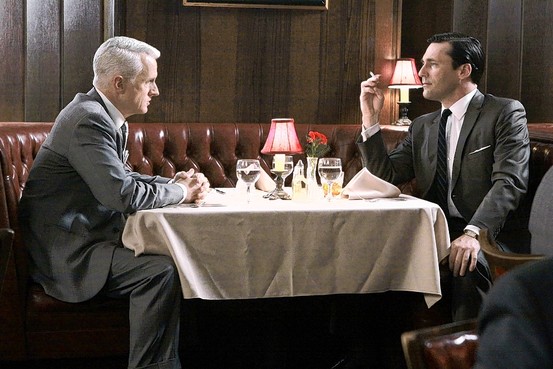
WELCOME BACK, "MAD MEN"!
❖❖❖
IN THIS ISSUE
SIPPING AND SAVORING SANTA BARBARA COUNTY
By John A. Curtas
NEW YORK CORNER
BLT Steak
By John Mariani
AU REVOIR TO A GREAT FRENCH CUISINIER
By John Mariani
NOTES FROM THE WINE CELLAR
Mondavi Family Estate
By Andrew Chalk
❖❖❖
SIPPING AND SAVORING
SANTA BARBARA COUNTY
by John A. Curtas
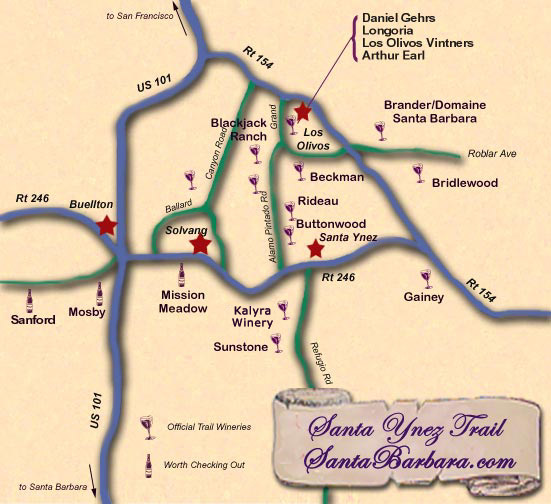
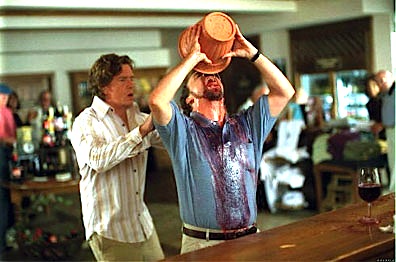 Before illuminating the
food and wine possibilities throughout the area, a
little geography lesson is in order. Calling the
Santa Barbara wine country the Santa Barbara Wine
Country is a bit misleading, since the vineyards and
wineries don’t even appear until you’re about forty
minutes north of the city. The Central Coast is a
more generalized description, but even that may
confuse the novice, since the entirety of the
Central Coast stretches roughly 250 miles from San
Francisco County to Santa Barbara County. No matter
what you call it, this area is huge, with more than
90,000 acres planted with wine grapes and home to
around 360 wineries. The good news is that Solvang
puts you right on the doorstep of all of it, and
over the past decade the entire town has developed a
food and winey vibe that matches the excellence of
the unique wines surrounding it.
Before illuminating the
food and wine possibilities throughout the area, a
little geography lesson is in order. Calling the
Santa Barbara wine country the Santa Barbara Wine
Country is a bit misleading, since the vineyards and
wineries don’t even appear until you’re about forty
minutes north of the city. The Central Coast is a
more generalized description, but even that may
confuse the novice, since the entirety of the
Central Coast stretches roughly 250 miles from San
Francisco County to Santa Barbara County. No matter
what you call it, this area is huge, with more than
90,000 acres planted with wine grapes and home to
around 360 wineries. The good news is that Solvang
puts you right on the doorstep of all of it, and
over the past decade the entire town has developed a
food and winey vibe that matches the excellence of
the unique wines surrounding it.Two other towns, both so tiny they make Solvang seem like San Francisco, compose the oenophilian epicenter of the area. Buellton is for the budget traveler, home to a few motels, one good restaurant, several diners, and
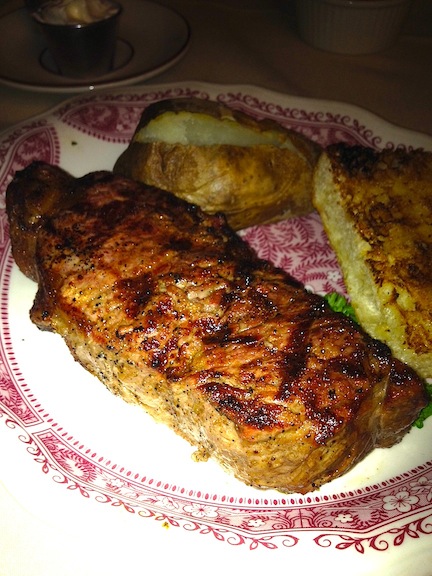 the only inn and eatery
in the world named after a legume soup: Pea Soup Andersen’s, and say what you will about, it has
endured for 90 years on the back of its thick and
silky broth, redolent of nostalgia and pea-ness. One
slurp of that soup, and a stroll around the
premises, will take you straight back to 1962.
Andersen’s is virtually unchanged since then in
offerings, accoutrements or attitude, and that’s
just the way it should be.
the only inn and eatery
in the world named after a legume soup: Pea Soup Andersen’s, and say what you will about, it has
endured for 90 years on the back of its thick and
silky broth, redolent of nostalgia and pea-ness. One
slurp of that soup, and a stroll around the
premises, will take you straight back to 1962.
Andersen’s is virtually unchanged since then in
offerings, accoutrements or attitude, and that’s
just the way it should be.The one good restaurant in town is also the famous one. The Hitching Post II is where “Sideways” (above) was filmed in 2003, and everyone stops by the bar to check out the modest wall of photos showing Miles and Jack (Paul Giamatti and Thomas Haden Church) doing their thing and posing with cast, crew and employees. What I love about HPII are the smoky “barbecued” steaks (right)--they call grilling “barbecuing” out here--and the ever-changing selections of Hartley-Ostini Hitching Post pinot noirs. What I don’t love is that nothing else on the menu rises to the level of those steaks--or the pea soup down the street. If I had to plan a meal over again, I’d start with some hap-pea-ness at Andersen’s, savor a steak and pinot at HPII, and grab a left-over Danish in my room for dessert.
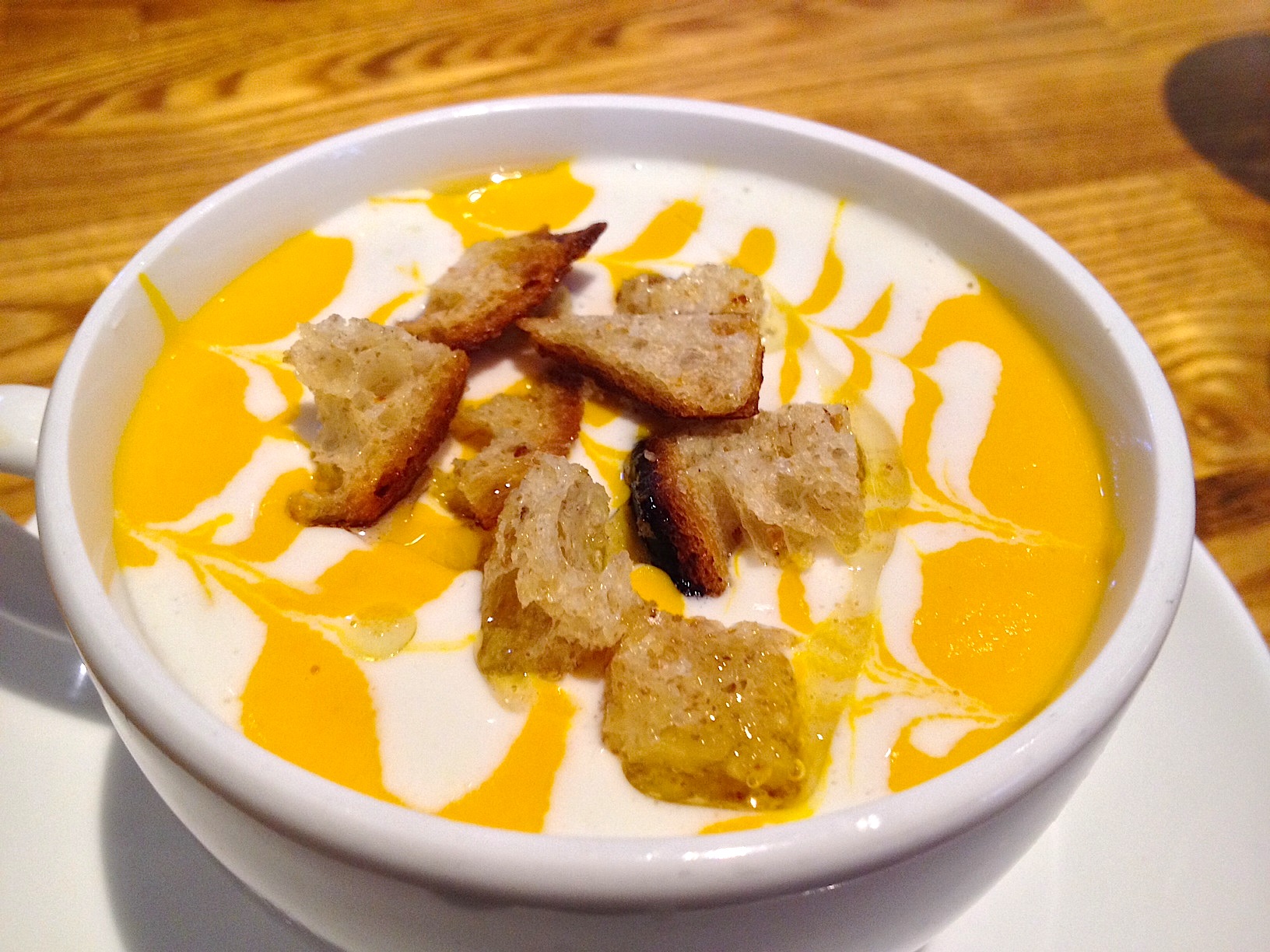 Meal
disappointments are quickly forgotten, however, once
you hit the two, tiny streets of Los Olivos, a
village that has also grown up a lot in the past
decade. What used to be barely a blip on the map,
with a single, tony B & B--the Fess Parker
Inn--is now home to more than a dozen
tasting rooms, art galleries, gift shops and one
serious restaurant, Sides. Located in the old Sides Hardware and
Shoes store, it is the perfect place to relax once
tasting fatigue sets in, and the minimalist menu
cleverly disguises some real serious work being done
in the kitchen. Our midday meal sounded as
utilitarian as a crescent wrench when we ordered it:
soup of the day--carrot-ginger (left)--fish
tacos and a corned beef sandwich. But what appeared
was house-made corned beef, sashimi-grade albacore,
and an intense, beautiful soup, revealing a certain
level of kitchen sophistication we had not
previously encountered in trips to the area.
Meal
disappointments are quickly forgotten, however, once
you hit the two, tiny streets of Los Olivos, a
village that has also grown up a lot in the past
decade. What used to be barely a blip on the map,
with a single, tony B & B--the Fess Parker
Inn--is now home to more than a dozen
tasting rooms, art galleries, gift shops and one
serious restaurant, Sides. Located in the old Sides Hardware and
Shoes store, it is the perfect place to relax once
tasting fatigue sets in, and the minimalist menu
cleverly disguises some real serious work being done
in the kitchen. Our midday meal sounded as
utilitarian as a crescent wrench when we ordered it:
soup of the day--carrot-ginger (left)--fish
tacos and a corned beef sandwich. But what appeared
was house-made corned beef, sashimi-grade albacore,
and an intense, beautiful soup, revealing a certain
level of kitchen sophistication we had not
previously encountered in trips to the area.Like most restaurants in the area, Sides charges only retail prices for the wines on its list, yet another reason to appreciate the unassuming nature of this wine region.
You could lose yourself just walking around the various Los Olivos sipping parlors--especially the Syrah-based beauties of Andrew Murray and Mikael Sigouin’s dense and vivid Grenache blends at the Kaena tasting room--but that would leave precious time to search out new finds, like the Beckmen Winery (just five minutes out of town, specializing in Rhône varietals) or visit old friends like the Quonset hut tasting room at Foxen, still as rustic and charming as ever twenty years after I first stumbled upon it.
Stumbling becomes a problem when you do eleven wineries in one day (helpful hint: learn to spit gracefully), and becoming wined-out
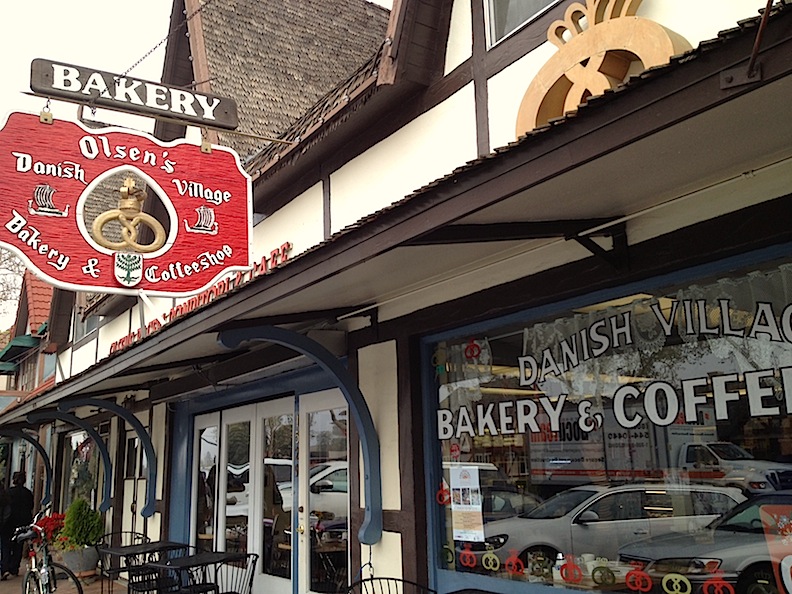 is a pitfall best
avoided by pacing yourself. Another way to dodge
this inconvenient truth is to walk a lot, and
nowhere in the area is more conducive to drinking
and strolling than Solvang. The town has undergone
quite a facelift, and what were once faded
storefronts and empty windows are now teaming with
tenants, an amazing number of which focus on eating
and drinking. Once you carbo-up with a kringle cake,
7 sisters coffee cake, or a cinnamon bun and sip
some remarkably good coffee from Olsen’s Danish
Village
Bakery, you’ll be ready to swirl and sip
all day.
is a pitfall best
avoided by pacing yourself. Another way to dodge
this inconvenient truth is to walk a lot, and
nowhere in the area is more conducive to drinking
and strolling than Solvang. The town has undergone
quite a facelift, and what were once faded
storefronts and empty windows are now teaming with
tenants, an amazing number of which focus on eating
and drinking. Once you carbo-up with a kringle cake,
7 sisters coffee cake, or a cinnamon bun and sip
some remarkably good coffee from Olsen’s Danish
Village
Bakery, you’ll be ready to swirl and sip
all day.
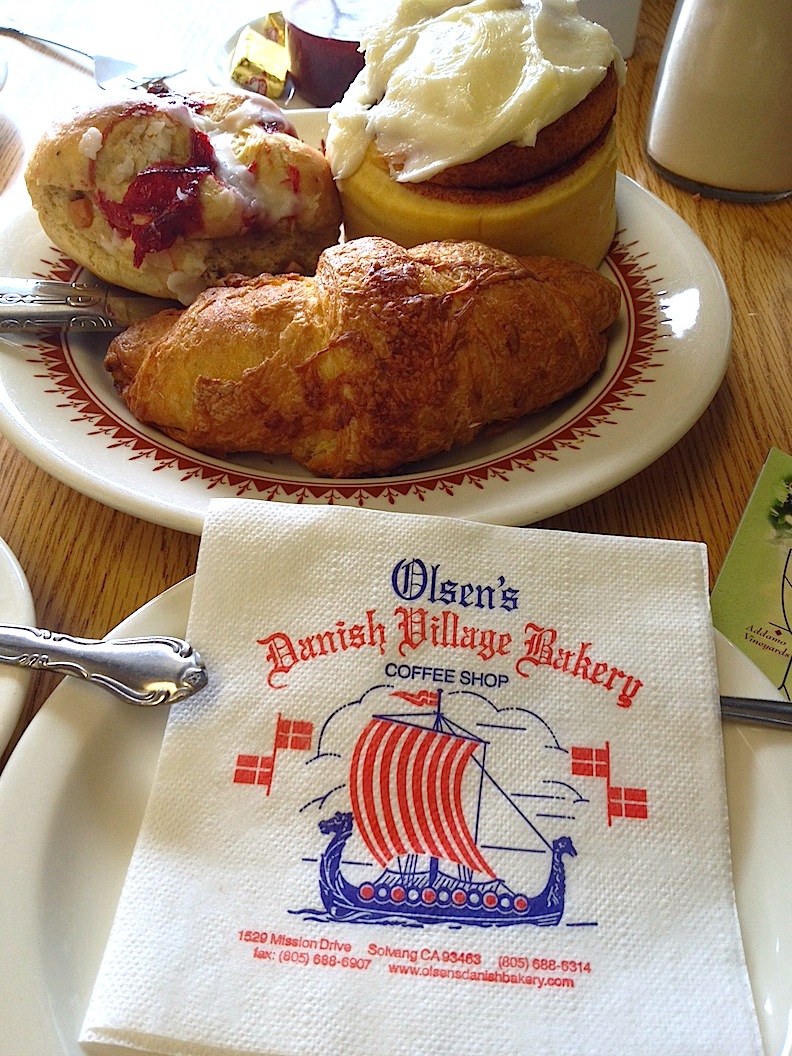 What used to seem an
afterthought in Solvang is now front and center, as
the town boasts a number of tasting rooms and wine
bars, all within a short walk of each other. The
great thing about wine bars, as opposed to tasting
rooms, is that you can sample bottles from
throughout the area, not just a single winery. The
great thing about The Good
Life is that they also serve fabulous
craft beers, along with some serious charcuterie,
and will happily chat you up about some obscure
stout or whatever pinot noir Lane Tanner has just
released. (Note: Lane Tanner sold her interest in
the “Lane Tanner Winery” in 2010; just as “Sanford
Wines” are no longer made by Richard Sanford. Both
individuals still make wines--under the Sierra Madre
and Alma Rosa labels, respectively--and the wines
are as worth seeking out as their winemakers are
difficult to keep up with.) After some cheese with
some California brews, it’s back to the barrels--in
this case the Toccata
Tasting Room--where Italian varietals
boasting big flavors at reasonable prices are the
rule.
What used to seem an
afterthought in Solvang is now front and center, as
the town boasts a number of tasting rooms and wine
bars, all within a short walk of each other. The
great thing about wine bars, as opposed to tasting
rooms, is that you can sample bottles from
throughout the area, not just a single winery. The
great thing about The Good
Life is that they also serve fabulous
craft beers, along with some serious charcuterie,
and will happily chat you up about some obscure
stout or whatever pinot noir Lane Tanner has just
released. (Note: Lane Tanner sold her interest in
the “Lane Tanner Winery” in 2010; just as “Sanford
Wines” are no longer made by Richard Sanford. Both
individuals still make wines--under the Sierra Madre
and Alma Rosa labels, respectively--and the wines
are as worth seeking out as their winemakers are
difficult to keep up with.) After some cheese with
some California brews, it’s back to the barrels--in
this case the Toccata
Tasting Room--where Italian varietals
boasting big flavors at reasonable prices are the
rule.The “Sideways Effect” did more than put Solvang in touch with its inner oenophile, it also
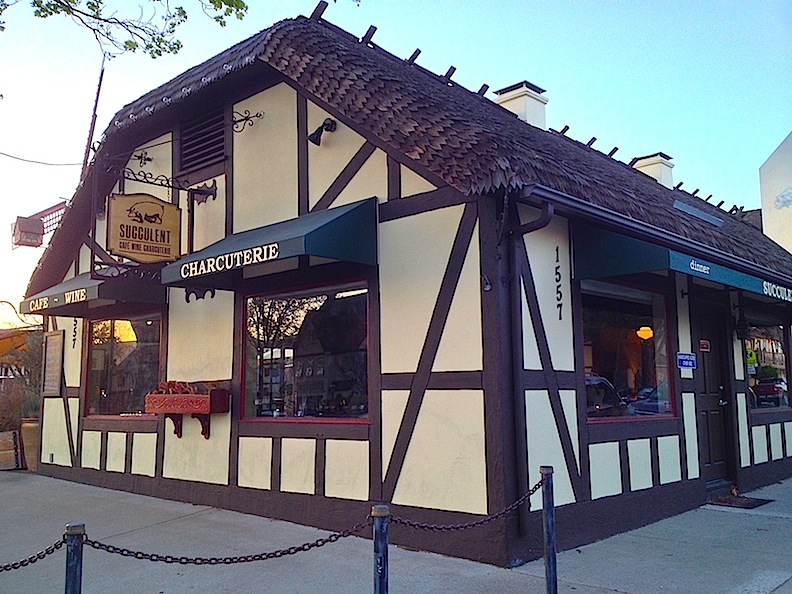 brought modern cuisine
to a place where the food used to be as dated as the
half-timbered architecture. Fifteen years ago, your
choices were either a chain restaurant or anything
you wanted as long as it was wrapped in a
pancake. These days, the town sports two
restaurants--Root 246
and the Succulent
Café (right)--with serious intentions.
brought modern cuisine
to a place where the food used to be as dated as the
half-timbered architecture. Fifteen years ago, your
choices were either a chain restaurant or anything
you wanted as long as it was wrapped in a
pancake. These days, the town sports two
restaurants--Root 246
and the Succulent
Café (right)--with serious intentions. My dinner at the SC--a house-made charcuterie platter, pumpkin seed-crusted rack of lamb, and bacon-wrapped diver scallops--married perfectly with a 2010 Ken Brown pinot noir. All of it was served by a wine-knowledgeable staff in a room where I couldn’t hear myself think. After dinner, I strolled past Root 246 , which had a raucous bar scene going on and what appeared to be a much quieter dining room. Everything on its menu (côte de boeuf, lamb 3 ways, cassoulet) seemed perfectly suited to the bold, smoky pinot noirs that put this region on the map, so we resolved to book it for our next trip to this delicious wine country, which I hope will be very soon.
❖❖❖
By John Mariani
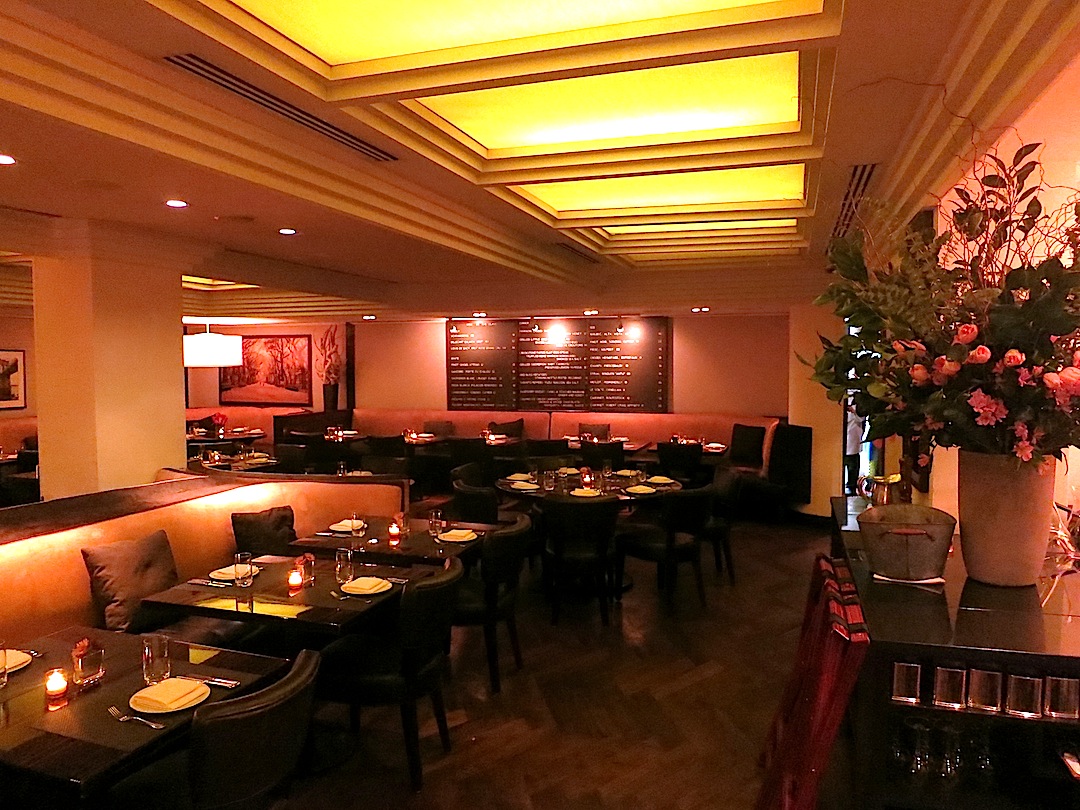 BLT Steak
BLT Steak
106 East 57th
Street
212-752-7470
BLT-Steak-New-York
It’s hard to imagine it’s
been ten years since the opening of BLT Steak,
a restaurant that had more influence on that
staid genre than any other up till then.
At the time I wrote, “The
room here is light and fresh, not burgundy or
glitzy; the staff is cordial and well informed
rather than brusque and kvetchy . . . The house
sandwich is, appropriately, the BLT--though this
one’s made with foie gras, which like everything
else here,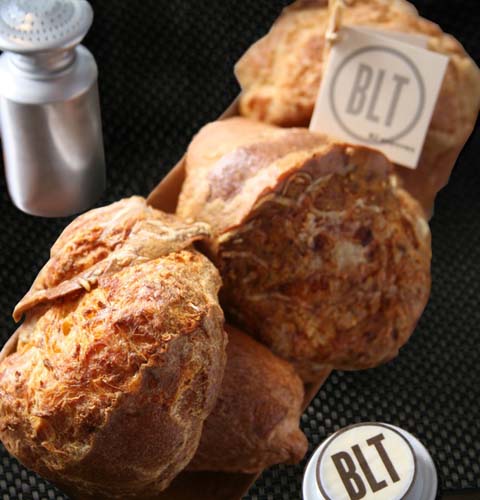 takes it to the next
level.”
takes it to the next
level.”
Partnering with ESquared
Hospitality, renowned French chef Laurent
Tourondel crafted an ebullient steakhouse where
women felt very welcome and men enjoyed bringing
them. The lighting was good, though the
decibel level was terrible. There was a blackboard
menu, ebony tables and suede booths. The
beef was Certified Black Angus and USDA Prime
cuts, the seafood from impeccable sources.
In all these
years--except for Laurent Tourondel leaving the
company to which he gave his initials (he now has
his own steakhouse called The Arlington
Club)--this BLT flagship, now with 12 branches
worldwide, has remained very much the same, and on
a recent visit it was so good to see some familiar
faces among the managers and captains, still
greeting customers with professionalism and gusto.
Even the noise level seems somewhat lower.
Only the prices have risen, but they are
commensurate with BLT’s myriad NYC competitors'.
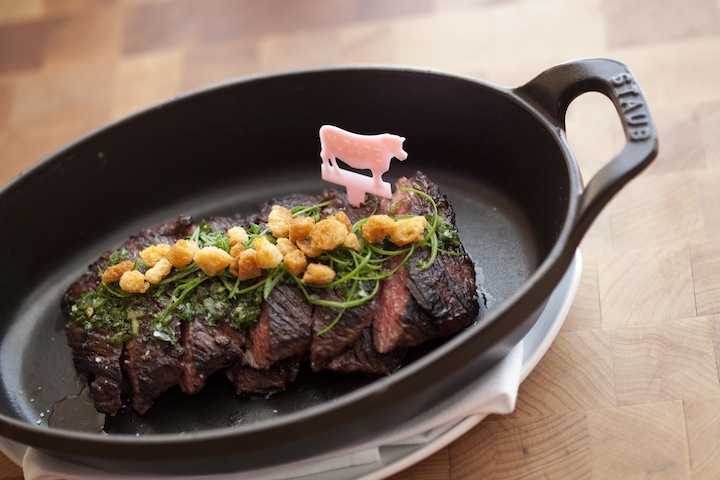 BLT
also pioneered the greatest cheese popover (right) the
world has ever seen--rising five inches in airy
splendor, very crisp on the outside, soft, eggy
and cheesy inside, and always brought to the table
very very hot, with plenty of butter.
BLT
also pioneered the greatest cheese popover (right) the
world has ever seen--rising five inches in airy
splendor, very crisp on the outside, soft, eggy
and cheesy inside, and always brought to the table
very very hot, with plenty of butter.
The
menu, overseen by Chef Clifford Crooks, is a
reasonable size, enough to satisfy the stalwart
carnivore as well as those who’d prefer seafood.
The tuna tartare with avocado ($18) made one
of its earliest NYC appearances here, and it’s
still one of the best in town. So, too, was
a lobster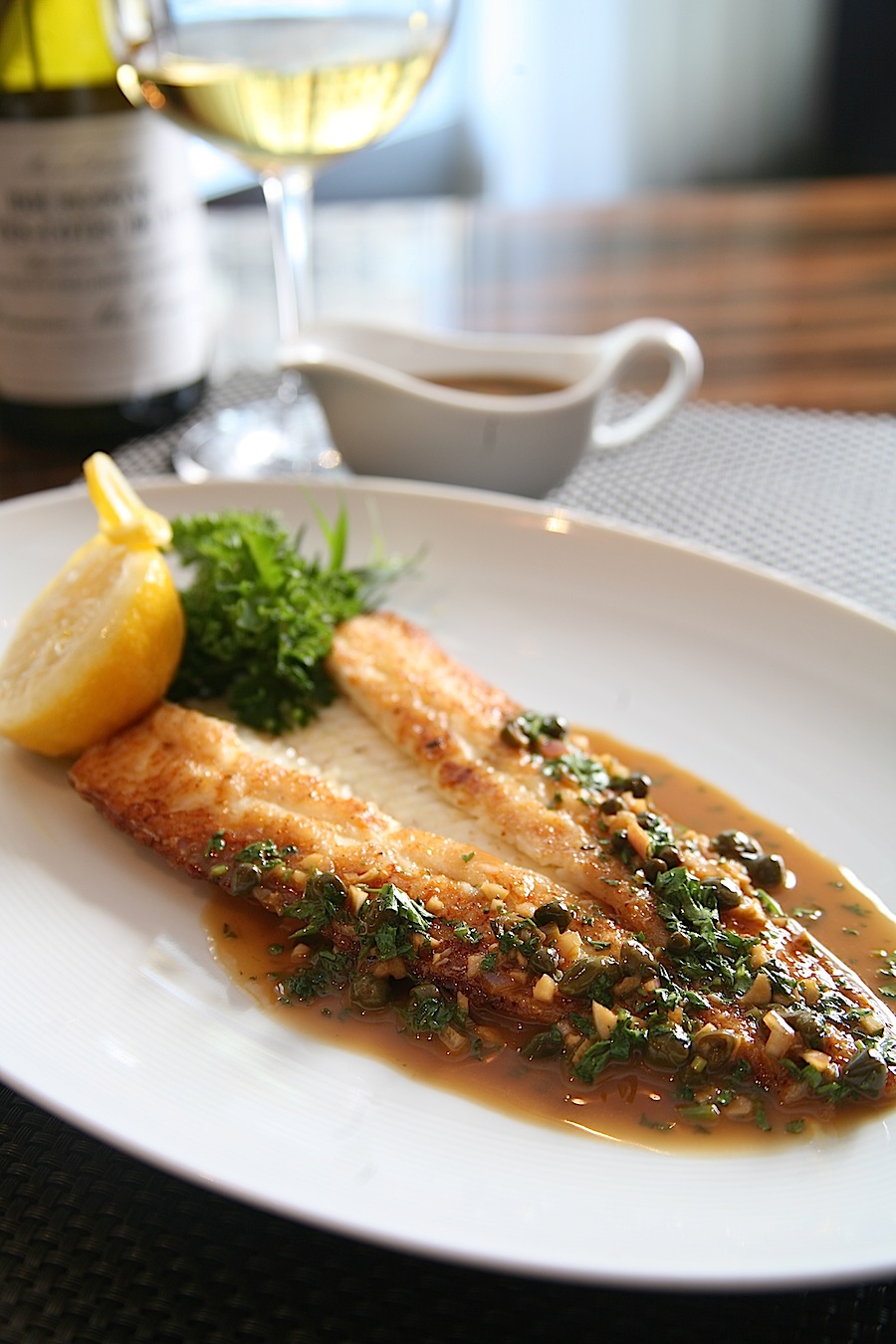 salad
($23), with plenty of big chunks of seafood in a
Cobb-like mince. There is, of course, a
seafood platter at $34, $65 or $98, and ask about
their fine charcuterie board.
salad
($23), with plenty of big chunks of seafood in a
Cobb-like mince. There is, of course, a
seafood platter at $34, $65 or $98, and ask about
their fine charcuterie board.
The
steaks and chops are impeccably cooked, charred
but juicy on the outside, medium-rare, as ordered,
inside. My favorite cut is the 28-day aged NY
strip weighing in at 16 ounces ($48), along with
the bone-in ribeye at 22 ounces ($49).
Highly surprising is the fact that BLT
serves inferior Australian lamb ($44), when
American lamb is so much better.
Knowing
I’d be noshing off my friends’ steaks, I opted for
sautéed Dover sole ($48) with a
soy-caper-brown butter sauce (right) I
asked to be put on the side, so as to appreciate
the full-fatted flavor of the sole, cooked on the
bone. A sautéed branzino ($30) came with
shiitakes, baby carrots, and the scent of
basil. There are always blackboard specials
posted.
Side dishes like hen of
the woods mushrooms, potatoes au gratin,
and Brussels sprouts seemed revolutionary on a
steakhouse menu back when BLT introduced them; all
that’s changed is their refinement. Creamed
spinach is really creamy, and the truffled mashed
potatoes and golden French fries will not last
long at any table.
Heidi
Kornhorst’s desserts, all $10, show a French
pastry slant, as in the superb signature
crêpe soufflé with passion fruit
sauce.
Sommelier Alex Berlingeri
stocks more than 500 global wines on his list, and
he is an ideal and amiable person to ask for
advice in any price
category.
So,
Happy Tenth Birthday, BLT. Don’t ever change
what you so distinctively pioneered.
BLT serves lunch Mon.-Fri. and dinner nightly.
AU REVOIR
TO A GREAT FRENCH CUISINIER
By John Mariani
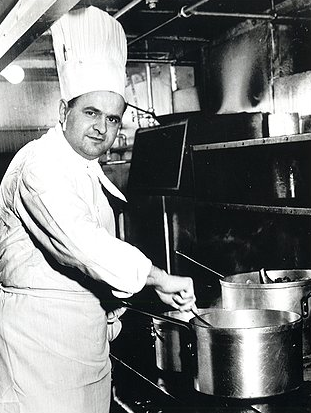 For
some in the food media, the death this week of
French master chef and
restaurateur Roger Fessaguet at 82 was yet
another blow to the legacy of fine
dining in NYC. Yet for me it
was more a case of “The king is dead, long
live the king!” For Fessaguet’s true
legacy was to leave an indelible trail of
impeccably crafted cuisine whose
principles of French classicism are still the
inspiration for fine dining at a
time when so many young chefs, held aloft by
the same media, delude themselves
into believing they are re-inventing the wheel
every time they pick up a knife.
For
some in the food media, the death this week of
French master chef and
restaurateur Roger Fessaguet at 82 was yet
another blow to the legacy of fine
dining in NYC. Yet for me it
was more a case of “The king is dead, long
live the king!” For Fessaguet’s true
legacy was to leave an indelible trail of
impeccably crafted cuisine whose
principles of French classicism are still the
inspiration for fine dining at a
time when so many young chefs, held aloft by
the same media, delude themselves
into believing they are re-inventing the wheel
every time they pick up a knife.
Back
in 1968 Fessaguet, then executive chef (later
partner) at the renowned La
Caravelle on West 55th
Street, made dishes praised by the Times’
restaurant
critic Craig Claiborne: “The stuffed turbot,
imported fresh from European waters but as sweet
in flavor and as tender in
texture as if it had been pulled within the hour
from the waters off Long
Island. The stuffing was Nantaise style — a
mousse of sole, fresh cream, deftly
mixed herbs such as rosemary, bay leaf and
thyme, and a suggestion of
shallots"--obviously
a
classic dish requiring immense precision to make
correctly, but one probably considered
passé today.
Yet imagine for a
moment that the same dish were to be found on the
menu at a hip new downtown
restaurant with an under-30, tattooed chef. Chances are the food press
would fawn over both the chef and
the dish, for Fessaguet’s dish is not so different
from one currently being
cooked up in Chelsea at the new Willow Road, as
described by The
New Yorker’s
Ariel Levy: “Risotto
is made with
barley, which the kitchen folds with fat clam
bellies, leeks, and a touch of
crème fraîche dissolved in clam
broth.”
It
is true that French Cuisine à la NYC had
become stultified on menus back in the
1960s when they were near Xerox copies of 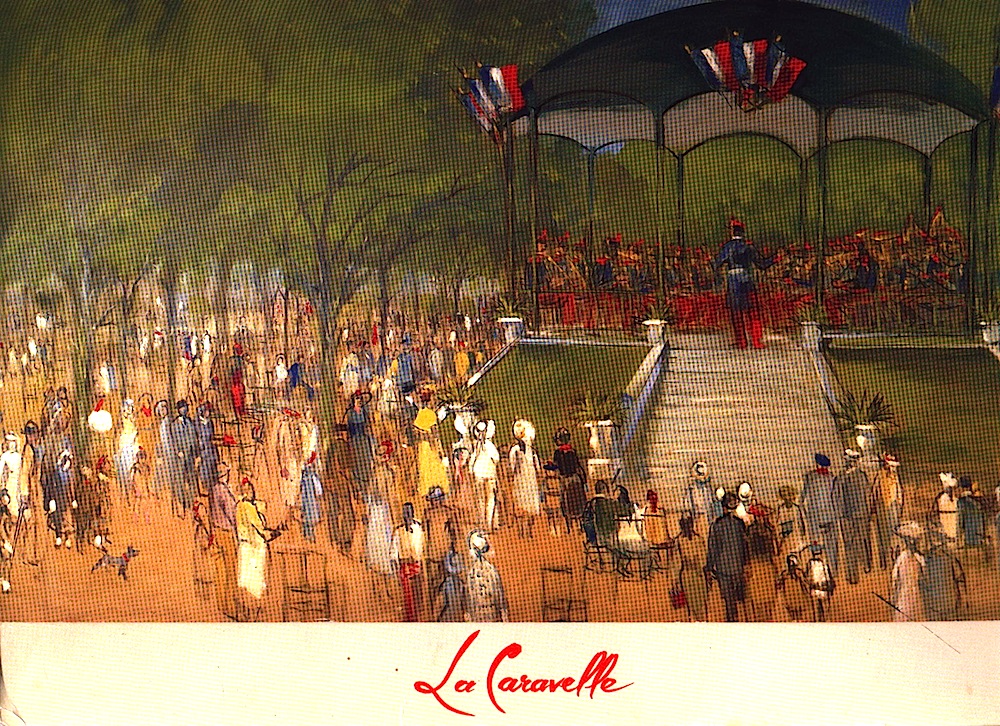 the one at
the most famous restaurants
of its day, Le Pavillon, where Fessaguet and La
Caravelle’s first owners, Fred
Decré and Robert Meyzen, had all worked.
But it was in the daily specials that chefs
like Fessaguet showed the
endless variations French classicism offered from
soup to dessert and
everything in between, all of it requiring
enormous training to produce—this at
a time when access to first-quality ingredients
was often impossible. No wild mushrooms, no
fresh foie gras, no virgin olive oil.
the one at
the most famous restaurants
of its day, Le Pavillon, where Fessaguet and La
Caravelle’s first owners, Fred
Decré and Robert Meyzen, had all worked.
But it was in the daily specials that chefs
like Fessaguet showed the
endless variations French classicism offered from
soup to dessert and
everything in between, all of it requiring
enormous training to produce—this at
a time when access to first-quality ingredients
was often impossible. No wild mushrooms, no
fresh foie gras, no virgin olive oil.
Fessaguet
was born in Villefranche sur Saône in 1931,
dropped out of school at 14 and
apprenticed at a wide range of restaurants in
France before coming to NYC to
work at Le Pavillon, then at La Caravelle,
becoming a partner in 1980.
From the
start, La Caravelle was a new kind of French
restaurant, far brighter and less
fussy than Le Pavillon and others in midtown, and,
although the snob factor was
still part of the ethos back then, La Caravelle
was a more ebullient place with
less attitude towards guests who did not have
names like regulars Prince
Rainier, Marlene Dietrich, Noël Coward,
Cecil Beaton, Igor Stravinsky, Pablo
Picasso, Salvador Dali, Oscar de la Renta, Ralph
Lauren, and Bill Blass.
The
premises were enlivened by impressionistic Jean
Pages murals of Paris, so that in 1977
Gourmet
Magazine wrote, “Seventeen years after its
launching, the restaurant
steers as steady a course as ever. Paris, dressed
in its holiday best and
transported to New York.” By then, Le Pavillon had
been shuttered for seven
years and La Caravelle had become a classic all
its own.
In 1980 Fessaguet retired from
the
kitchen but still was a formidable eminence in the
dining room, where his infectious bonhomie was
palpable.
Stout and ruddy-faced, the very image of
the French chef, he always had a twinkle in his
eye, a nose built for sniffing wine, knew his
social strengths, and hobnobbed with his French
colleagues on weekends. Fessaguet would leave
service
early on Saturday, hop in his Porsche and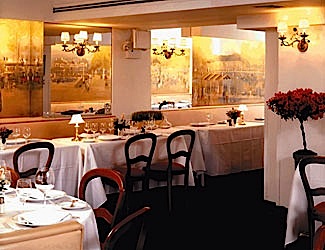 speed headlong to his
New England
country house, returning on Monday afternoon in
time for dinner.
speed headlong to his
New England
country house, returning on Monday afternoon in
time for dinner.
Eventually
La Caravelle was sold to André Jammet (his
father had run Le Bristol
Hotel in Paris) and his wife Rita, who maintained
the restaurant’s eminence while freshening
the menu by bringing in an impressive number of
young chefs who went on to
great careers of their own, including Michael
Romano, Cyril Rénaud, David
Pasternak and Tadashi Ono. La Caravelle closed in
2004, owing not
to changes
in culinary fashion but to the hard facts of NYC
realty: a new owner of the
building wanted a fortune for a new lease.
Meanwhile
Fessaguet,
whom I only really knew after he’d left his
kitchen for the dining
room, was enjoying his retirement with friends,
perhaps lamenting a certain
decline in civilized dining but never for a moment
in doubt of the power and
glory of French cuisine as the underpinning of all
modern non-Asian gastronomy.
He
was once one of many respected masters in NYC back
then; now none of his kind is left working in NYC.
But
their influence is everywhere, in every kitchen,
whether a young chef who’s
never eaten turbot with sauce Nantaise knows it or
not. At
a time when chefs have become
celebrities and smug egomaniacs, it is a good
thing to remember what Duke
Ellington said when asked what he really thought
of an old-timer like Louis
Armstrong. Ellington just smiled and said, “No he,
no me.”
❖❖❖
NOTES FROM THE WINE CELLAR
Keeping
It In The Family At Michael Mondavi
Family Estate
By
Andrew Chalk
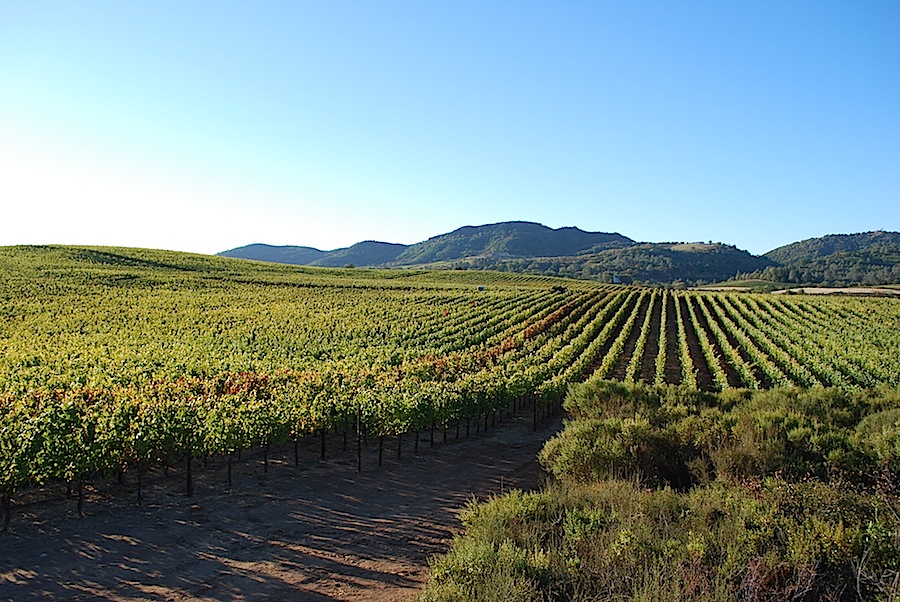
Animo Vineyard, Napa Valley
It was an historic moment when Robert
Mondavi founded his eponymous winery in 1966.
What is less well known is that he jointly
founded it with his oldest son, Michael. More
than just a name on a legal document, Michael
was actively involved in the establishment and
evolution of that winery with its focus on
superior wines and made the wine for the first
eight years of its existence. Subsequently, he
took charge of sales and marketing and later
became CEO.
Some wine it was. The first Robert Mondavi
Winery Reserve Cabernet Sauvignon that I ever
tasted was the 1974. It bested the bunch at a 1984
private tasting of great California 1974 red wines
and is one of the wines that helped put the Robert
Mondavi Winery name on the map.
Michael left the winery in 2004, shortly
before its acquisition by Constellation Brands,
and founded a company to import wines from
family-owned and managed wineries, Folio Wine
Partners; two years later he launched a new
boutique winery, Michael
Mondavi Family Estate, where he and his wife Isabel make wine
with their son, Rob, and daughter Dina (below). Their
first wine. “M by Michael Mondavi,” was
released in 2008.
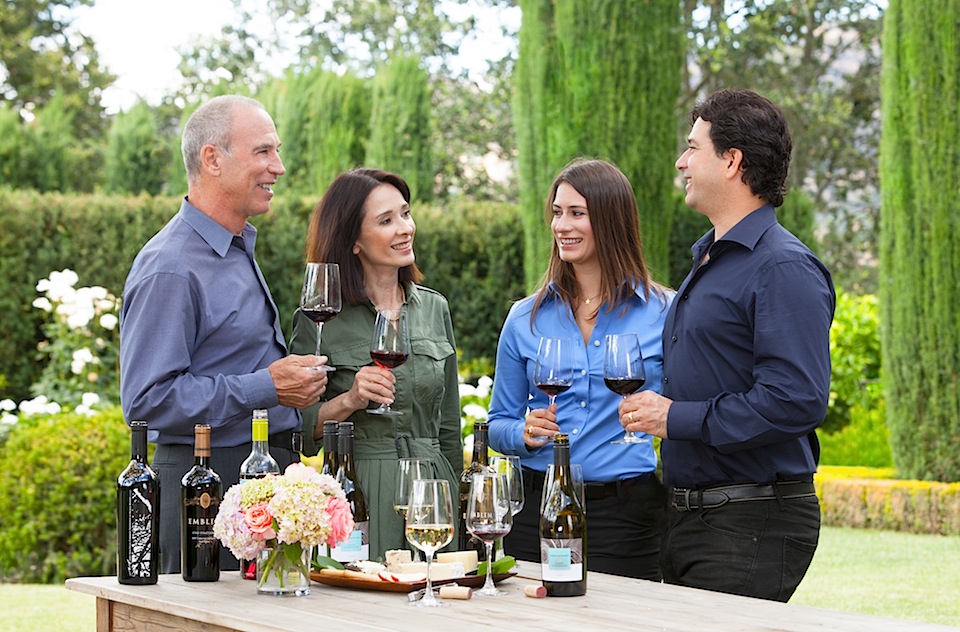 There is an
unmistakable family structure to affairs at the
winery. Michael is in overall charge but clearly
wants to delegate to his children. Rob is
President of Winemaking, Dina is in charge of
marketing. They make seven different wines
totalling just 18,000 cases a year. They source
fruit from throughout Napa Valley but pride of
place goes to the family-owned vineyards. Animo
Vineyard (above)--Italian
for spirit or soul--is 15 acres located on Atlas
Peak at 1,270-1,350 feet. The soil is rocky and
volcanic and planted to Cabernet Sauvignon Clone 4
on 110R rootstock. This vineyard was purchased by
Michael in 1996 and planted from scratch. As a
result, current releases are from vines that are
10-15 years old.
There is an
unmistakable family structure to affairs at the
winery. Michael is in overall charge but clearly
wants to delegate to his children. Rob is
President of Winemaking, Dina is in charge of
marketing. They make seven different wines
totalling just 18,000 cases a year. They source
fruit from throughout Napa Valley but pride of
place goes to the family-owned vineyards. Animo
Vineyard (above)--Italian
for spirit or soul--is 15 acres located on Atlas
Peak at 1,270-1,350 feet. The soil is rocky and
volcanic and planted to Cabernet Sauvignon Clone 4
on 110R rootstock. This vineyard was purchased by
Michael in 1996 and planted from scratch. As a
result, current releases are from vines that are
10-15 years old.
Oso Vineyard, purchased in 2006, is at the
other end of Napa Valley between Sugarloaf and
Howell Mountain at 1,250 feet, its vines planted
on stone-lined terraces in rocky, porous soil.
Excellent drainage stresses the vines, leading to
concentration of flavors, and the smaller diurnal
shift than on the valley floor, with warmer nights
and cooler days, results in fresh, vibrant fruit.
The Isabel
Mondavi (below,
right) line includes a Chardonnay ($30),
a Pinot Noir ($40) and a rosé ($20). The
latter is especially unusual for being made
almost entirely (91.5%) from Cabernet Sauvignon,
the remainder Petit Verdot. The fullness of the
Cabernet fruit makes this a more fruity and
beefier rosé than most. It is enjoyable on
hot days as an aperitif wine or with Mediterranean
hors d’oeuvres.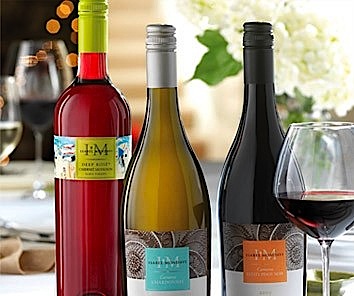
The 2011
Emblem Oso Vineyard Cabernet Sauvignon, with 87%
Cabernet Sauvignon, and 13% Petit Verdot ($60),
is a more structured wine than the Napa
Emblem. Unlike many producers, the winery does not
appear to have been negatively impacted by the
cool growing conditions of this vintage, allowing
a longer hang time to achieve full ripeness. If
you consume this wine now, choose a well-marbled
steak such as rib eye or T-bone and salt it well.
It will cut through the tannins. Better still, age
3-6 years to allow the wine to resolve.
The tête de cuvée wines of the
house are those from the Animo Vineyard. The 2010 Animo
Vineyard Cabernet Sauvignon, Atlas Peak,
with 87%
Cabernet Sauvignon and 13% Petit Verdot ($85), is
picked in multiple passes, then cold-soaked for
four days after destemming. Aging is for 20 months
in 87% new French oak. The result is very
concentrated fruit and hints of vanilla and spice.
The tannins are supple enough to drink now, albeit
with the same steak advisory as above, but this
wine will keep and improve a decade or more.
The flagship wine is the 2009 “M by
Michael Mondavi” Animo Vineyard Cabernet
Sauvignon, Atlas Peak, with 96% Cabernet
Sauvignon and 4% Petit Verdot ($199). The
objective here was to craft a wine redolent of the
Robert Mondavi Reserve Cabernets of the 1960s and
early 1970s. It is sourced from the “Crown Block”
in the Animo Vineyard harvested over four weeks
starting with the highest elevation and working
down. The harvested fruit is hand-selected,
destemmed and lightly crushed. The grapes see a
5-day cold-soak period, fermentation at 27-30⁰C and extended
post-fermentation maceration for around three
weeks. Aging is in 87% new French oak for 22
months, followed by 15 months in bottle.
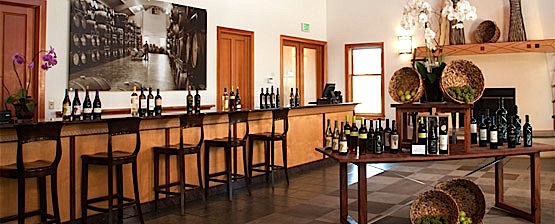 This is a wine
to cellar with your other “reference Napa
Cabernets” as a marker of the evolution of Napa
styles and effects of vintage variation. It is
immensely concentrated with formidable tannins,
dark fruit, black pepper and cooking spices. Keep
10-20 years.
This is a wine
to cellar with your other “reference Napa
Cabernets” as a marker of the evolution of Napa
styles and effects of vintage variation. It is
immensely concentrated with formidable tannins,
dark fruit, black pepper and cooking spices. Keep
10-20 years.
In one sense, Michael Mondavi Family Estate
is Robert Mondavi Winery redux; in another, it has
evolved. The commitment to Napa fruit and the
iconographic Cabernet Sauvignons that the terroir
produces is as strong as ever. But whereas Robert
chose To-Kalon on the valley floor, Michael
prefers mountain fruit. And whereas Robert
revolutionized viniculture with the laboratory and
squeaky-clean winemaking (a vital step in those
days), Michael practices the minimal intervention
and sustainability practices front and center in
this century.
For wine drinkers, all seven wines here are
interesting and many tasted at the winery (left). The
single most important piece of news, if you pinned
me down and forced me to confess, is that “M by
Michael Mondavi” is a candidate for admission to
the pantheon of top-tier Napa Cabernet Sauvignons.
❖❖❖
Wine
Column Sponsored by Banfi Vintners
Reliable Old Friends
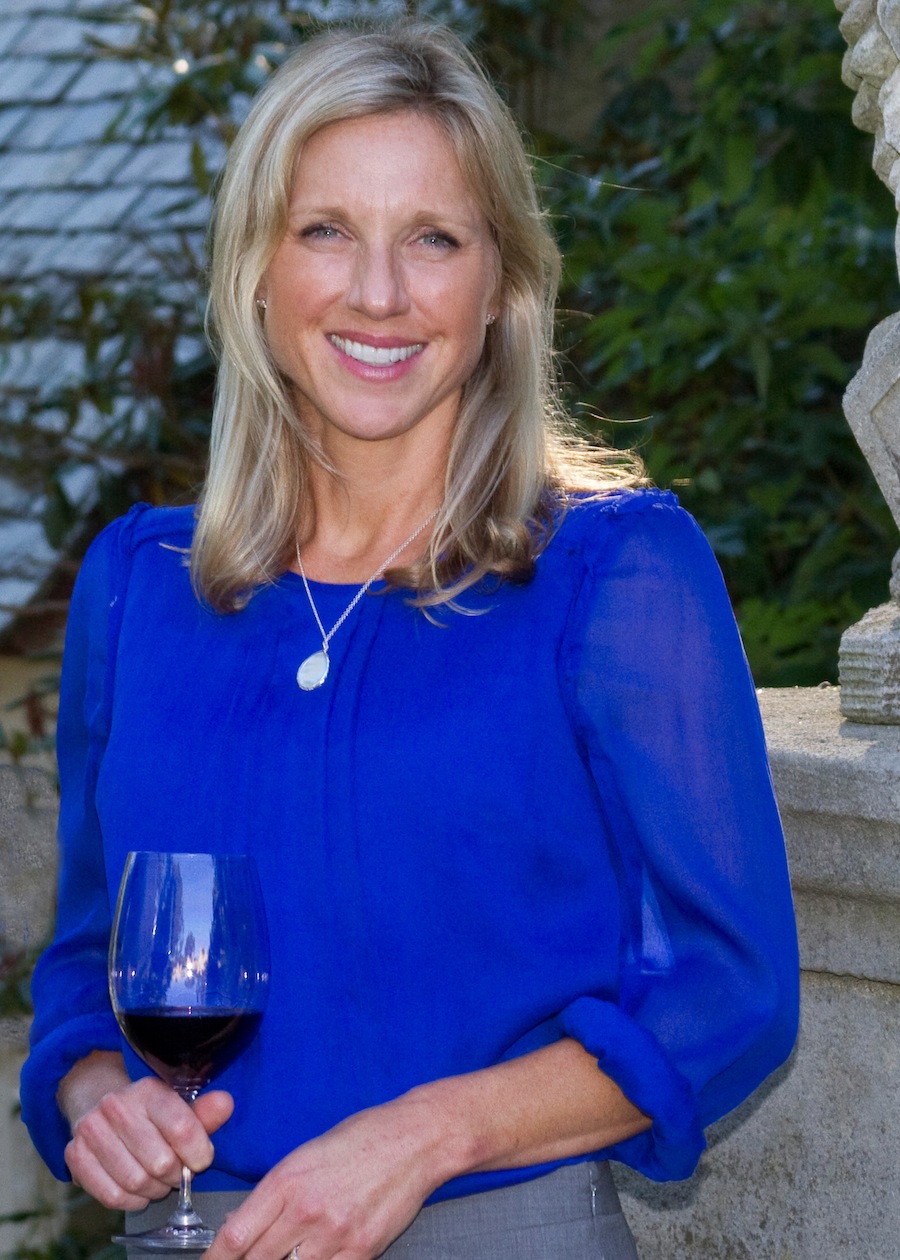
by Cristina Mariani-May
co-CEO of Banfi
Vintners America's leading wine importer
April
Showers of Red and White Goodness
As
Spring finally kicks into gear, we are reminded of
the fragility of Mother
Earth and her bounty.
As an
importer representing several family wine makers
from around the globe, I often
like to point out that all the wines that we
represent are green, some of them
greener than others.
The greenest
of all are classified as Biodynamic or certified
Organic. One
of the most interesting selections
of eco-balanced, organic and biodynamic wines comes
to us from Chile and the
vineyards of Emiliana.
Emiliana
was founded by our friends, the Guilisasti family,
who have a long and proud
history of winemaking with their Concha y Toro
brand. Three decades ago, well ahead
of the curve that has made
organic wines all the rage today, they set up
dedicated and, most important
for organic farming, isolated vineyards for this 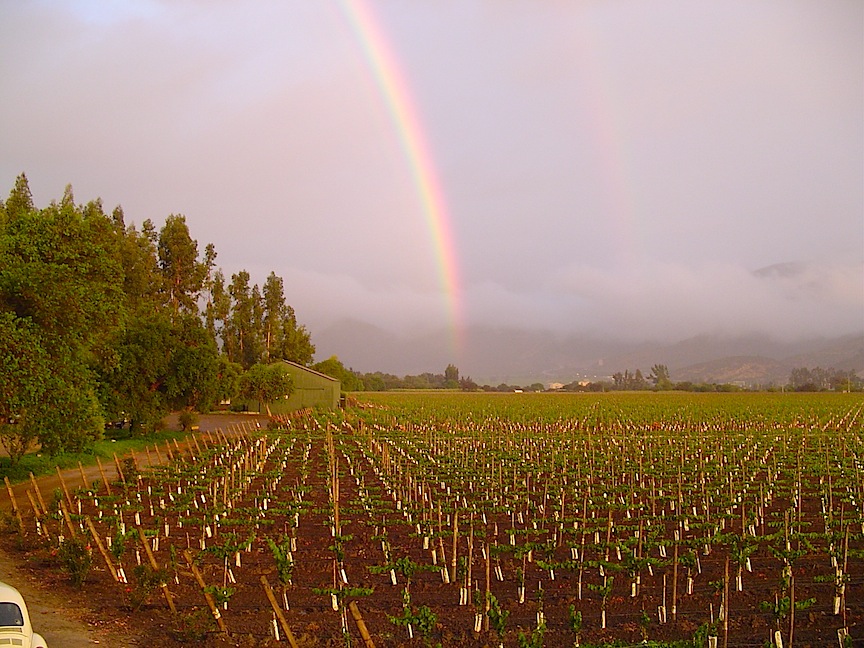 type of agriculture. Many may
picture the small farmer as
being the most “organic,” but in the reality of our
wine world, sometimes it
takes the “big guys” to act as a locomotive to get a
movement such as this on
track.
type of agriculture. Many may
picture the small farmer as
being the most “organic,” but in the reality of our
wine world, sometimes it
takes the “big guys” to act as a locomotive to get a
movement such as this on
track.
Organic farming is a form of
agriculture which
avoids or largely excludes the use of synthetic
fertilizers and pesticides,
plant growth regulators, and livestock feed
additives. Organic
farmers rely on crop rotation,
crop residues, animal manures--including llamas (below)--and
mechanical cultivation to maintain soils
productivity and health, to supply plant nutrients,
and to control weeds,
insects and other pests. To call a
wine organic in the US, government regulation says
that it must be produced
from 95% organically grown ingredients with no added
sulfites. If
you add sulfites in the relatively
minimal amount of 100 parts per million, you can
only say that the wine is “made
from organically grown grapes.”
Now, not to go into a chemistry lesson, but
it is virtually impossible
to make a wine without that modest dose of sulfites,
at least if you want to
drink it beyond ten feet of the cellar it was made
in and wish it to survive any
moderate amount of aging.
Biodynamic farming adheres to the
same
principles, but takes it one step further by relying
on the cycles of the moon
and the sun to dictate much of what is done in the
field, and uses animal
treatments such as compost teas, horns buried with
fertilizer, deer bladders,
etc., to
treat the soil.
It may
sound a little hocus pocus, but in reality it is
very comparable to homeopathic
medicine, using the body’s (in this case, the
earth’s) own energy to heal
itself.
Emiliana has four distinct
collections of
lovingly crafted organic wine now available in the
US – the base line of
Natura, the next step up in Novas, a stand-alone
wine in Coyam, and the
ne-plus-ultra of bio-dynamic wines, Ge.
One taste of any of these and you too may
find yourself turning green –
not with envy, but for a newfound love of organic
winemaking!
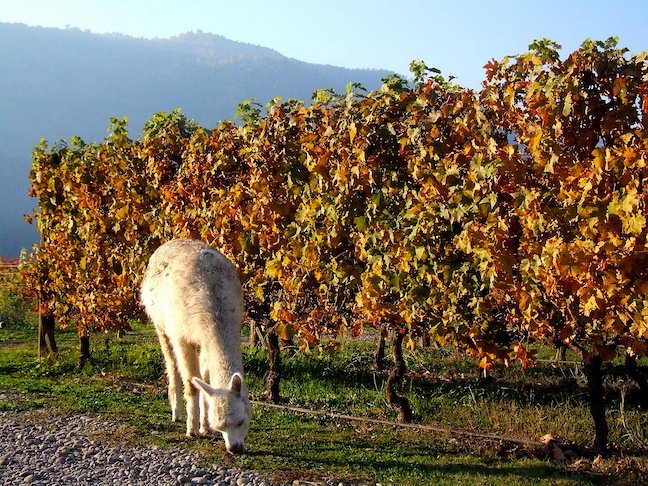 Recommended
– green wines for Spring:
Recommended
– green wines for Spring:
Natura
Chardonnay In
the cool coastal Pacific climate of the Casablanca
Valley, organically grown
grapes are hand picked during the last week of
March, and vinified in stainless
steel tanks, free of the domineering influence of
oak. On
the nose, tantalizing citrus aromas
of grapefruit and lime blend with notes of
pineapple, all of which reappear on
the palate and finish with balance thanks to the
wine’s freshness and natural
acidity. Delicious
with spring
salads and seafood dishes.
Natura
Carmenere – From the
rustic isolation of the Colchagua Valley, this
intense and voluptuous offers
aromas of cherries, chocolate and spice, coming
together in ramped up volume on
the palate with soft, round tannins and firm,
well-balanced structure. Great balance between fruit
and oak,
with a long, juicy finish.
Novas Sauvignon Blanc
Gran Reserva – Hailing
from the San Antonio
Valley’s thin rocky and clay soils, the organic
grapes for this wine are
harvested by hand in March and undergo
fermentation in stainless steel to
preserve their bright fruit character.
Herbal notes mixed with citrus and soft
floral hints fill the bouquet;
the taste is medium bodied with grapefruit flavors
joined by a delicate acidity
and a touch of minerality.
Novas
Pinot Noir Gran Reserva – The
grapes for this wine are
grown in the cool, coastal Casablanca Valley’s
permeable sandy loam soils, 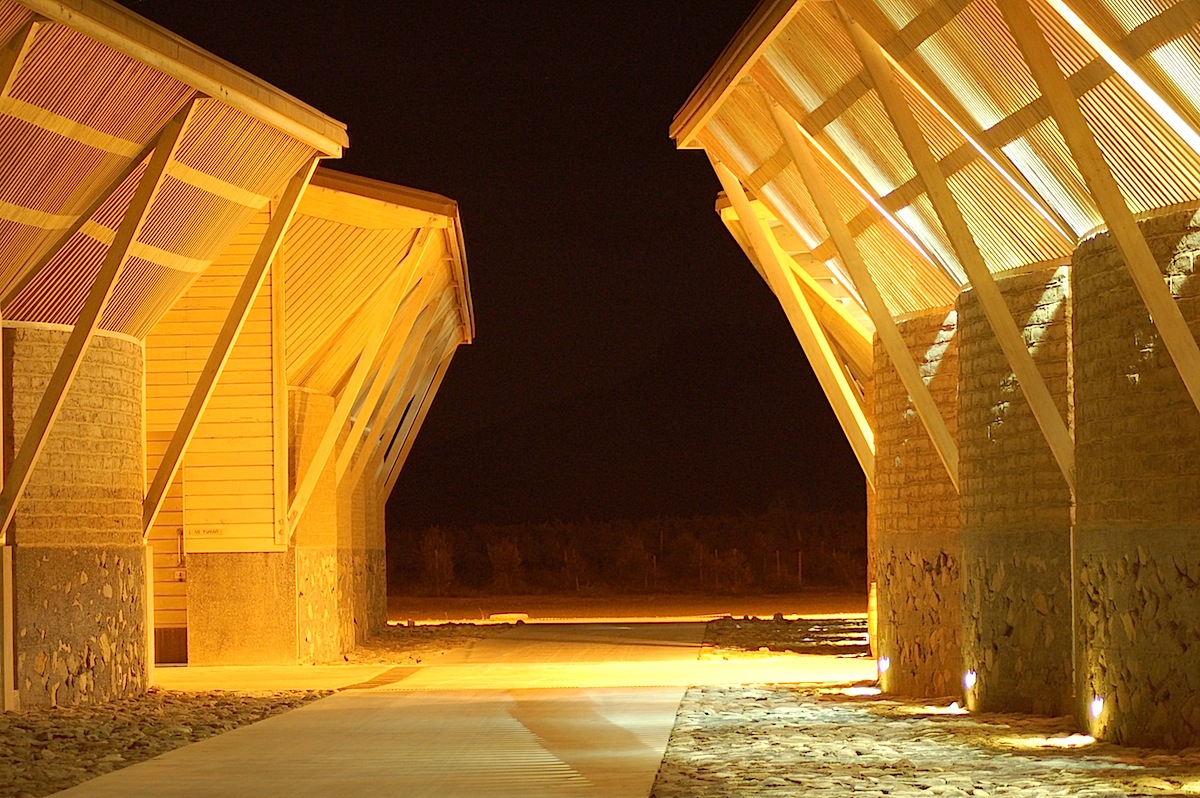 and
harvested by hand.
After a cold
soak on the skins, the wine is aged for 8 months
in French oak barrels to add
character, depth and roundness. Bright
ruby red in color with attractive aromas of
berries, strawberries and notes of
spice and cocoa, this wine bursts with fruit
flavor, layered with earthiness.
Delicious with white meats, light sauces, full
flavored fish and shellfish,
cured ham and sushi.
and
harvested by hand.
After a cold
soak on the skins, the wine is aged for 8 months
in French oak barrels to add
character, depth and roundness. Bright
ruby red in color with attractive aromas of
berries, strawberries and notes of
spice and cocoa, this wine bursts with fruit
flavor, layered with earthiness.
Delicious with white meats, light sauces, full
flavored fish and shellfish,
cured ham and sushi.
Coyam
– A
blend dominated by Syrah with
nearly equal parts of Carmenere and Merlot
balanced by “soupcons” of Cabernet
Sauvignon, Mourvedre and Petit Verdot, from the
Colchagua Valley estate called
Los Robles – Spanish for the oaks,
called “Coyam” by the native Mapuche people in
their own language. Hand
harvested certified biodynamic grapes are
naturally fermented in French oak
barrels. Coyam
is largely
unfiltered and aged for 13 months in barrels. Aromas of ripe red and black
fruits integrate with notes of
spice,  earth and a hint of
vanilla bean.
Elegant expressions of fruit are delicately
interwoven with oak, mineral
and toffee.
earth and a hint of
vanilla bean.
Elegant expressions of fruit are delicately
interwoven with oak, mineral
and toffee.
Ge
– Chile’s
first certified biodynamic
wine, the name Ge is a nod to Geos, the earthly
environment pulling together
all the elements that surround us.
Ge is a blend of nearly equal parts of
Syrah, Carmenere and Cabernet
Sauvignon grown in the deep soils of colluvial
origin in the coastal range,
which lends mineral complexity. Naturally
fermented in oak barrels, Ge is deep
plum red with violet tones; it offers intense
aromas of black fruits and
berries alongside mineral notes and a soft touch
of tobacco leaf.
Generously fruity with cedar notes, Ge
is well balanced with tremendous volume, well
rounded tannins and a long
finish.
For
more information please visit
http://www.banfiwines.com/winery/emiliana/
WHY THERE'LL ALWAYS BE AN ENGLAND

 VAT YOU CALL
,"OBSESSIONS"?
VAT YOU CALL
,"OBSESSIONS"? "For the last several years, I have been obsessed with the Vietnamese snack known as nem nuong, charcoal-grilled pork most often eaten with herbs as a component of a rice-paper roll."--Jonathan Gold, "Brodard Chateau elevates Vietnamese street food," LA Times (3/21/14)
Any of John Mariani's
books below may be ordered from amazon.com.
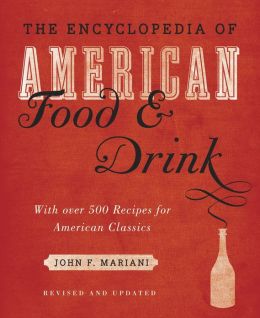 |
The Encyclopedia of American Food and Drink by John F. Mariani (Bloomsbury USA, $35) Modesty forbids me to praise my own new book, but let me proudly say that it is an extensive revision of the 4th edition that appeared more than a decade ago, before locavores, molecular cuisine, modernist cuisine, the Food Network and so much more, now included. Word origins have been completely updated, as have per capita consumption and production stats. Most important, for the first time since publication in the 1980s, the book includes more than 100 biographies of Americans who have changed the way we cook, eat and drink -- from Fannie Farmer and Julia Child to Robert Mondavi and Thomas Keller. "This book is amazing! It has entries for everything from `abalone' to `zwieback,' plus more than 500 recipes for classic American dishes and drinks."--Devra First, The Boston Globe. "Much needed in any kitchen library."--Bon Appetit. |
"Eating Italian will never be the same after reading John Mariani's entertaining and savory gastronomical history of the cuisine of Italy and how it won over appetites worldwide. . . . This book is such a tasteful narrative that it will literally make you hungry for Italian food and arouse your appetite for gastronomical history."--Don Oldenburg, USA Today. "Italian
restaurants--some good, some glitzy--far
outnumber their French rivals. Many of
these establishments are zestfully described
in How Italian Food Conquered the World, an
entertaining and fact-filled chronicle by
food-and-wine correspondent John F.
Mariani."--Aram Bakshian Jr., Wall Street
Journal.
"Equal parts
history, sociology, gastronomy, and just
plain fun, How Italian Food Conquered the
World tells the captivating and delicious
story of the (let's face it) everybody's
favorite cuisine with clarity, verve and
more than one surprise."--Colman Andrews,
editorial director of The Daily
Meal.com. "A fantastic and fascinating
read, covering everything from the influence
of Venice's spice trade to the impact of
Italian immigrants in America and the
evolution of alta cucina. This book will
serve as a terrific resource to anyone
interested in the real story of Italian
food."--Mary Ann Esposito, host of PBS-TV's
Ciao
Italia. "John Mariani has written the
definitive history of how Italians won their
way into our hearts, minds, and
stomachs. It's a story of pleasure over
pomp and taste over technique."--Danny Meyer,
owner of NYC restaurants Union Square
Cafe, The Modern, and Maialino.
|
 |
 |
 |
 |
 |
 |
 |
 |
 Everett Potter's Travel Report:
Everett Potter's Travel Report: 
 Eating Las
Vegas is the new on-line site for
Virtual Gourmet contributor John A. Curtas.,
who since 1995 has been commenting on the
Las Vegas food scene and reviewing
restaurants for Nevada Public Radio.
He is also the restaurant critic for KLAS
TV, Channel 8 in Las Vegas, and his past
reviews can be accessed at KNPR.org.
Click on the logo below to go directly to
his site.
www.eatinglv.com
Eating Las
Vegas is the new on-line site for
Virtual Gourmet contributor John A. Curtas.,
who since 1995 has been commenting on the
Las Vegas food scene and reviewing
restaurants for Nevada Public Radio.
He is also the restaurant critic for KLAS
TV, Channel 8 in Las Vegas, and his past
reviews can be accessed at KNPR.org.
Click on the logo below to go directly to
his site.
www.eatinglv.com

Tennis Resorts Online: A Critical Guide to the World's Best Tennis Resorts and Tennis Camps, published by ROGER COX, who has spent more than two decades writing about tennis travel, including a 17-year stretch for Tennis magazine. He has also written for Arthur Frommer's Budget Travel, New York Magazine, Travel & Leisure, Esquire, Money, USTA Magazine, Men's Journal, and The Robb Report. He has authored two books-The World's Best Tennis Vacations (Stephen Greene Press/Viking Penguin, 1990) and The Best Places to Stay in the Rockies (Houghton Mifflin, 1992 & 1994), and the Melbourne (Australia) chapter to the Wall Street Journal Business Guide to Cities of the Pacific Rim (Fodor's Travel Guides, 1991).


MARIANI'S VIRTUAL GOURMET
NEWSLETTER is published weekly. Editor/Publisher: John
Mariani.
Editor: Walter Bagley. Contributing Writers: Christopher Mariani,
Robert Mariani, John A.
Curtas, Edward Brivio, Mort Hochstein, Suzanne
Wright, and Brian Freedman. Contributing
Photographers: Galina Stepanoff-Dargery,
Bobby Pirillo. Technical Advisor: Gerry McLoughlin.
To un-subscribe from this newsletter,click here.
© copyright John Mariani 2014
